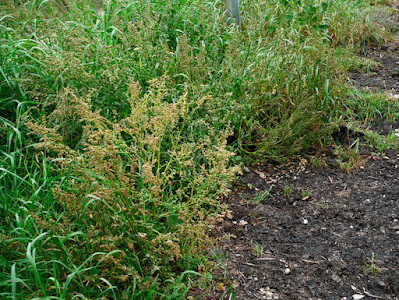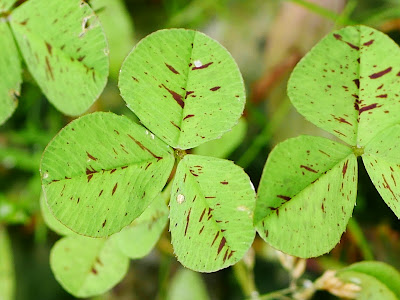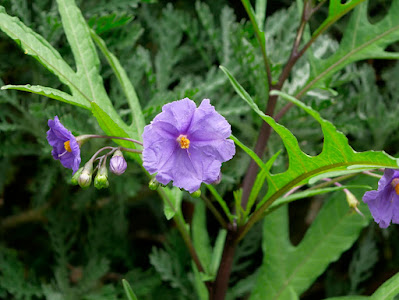Summer has gone, but the plants don't necessarily follow our calendar. There are always new species and plants to find, so I go out looking all year round as and when I can. Below are some of the interesting plants I found this last September in Cornwall.
Field Gentian is a species I'd not seen before, and in late August, spurred on by photos online of flowering plants from as far north as Cumbria, I searched for them in Cornwall. I didn't find any! It seems the Cornish plants do not flower until well into September for some reason. So I travelled down to the Lizard Downs to try and find some and I was successful, finding around 100 plants in total along a dry track about a mile inland from Kynance Cove. Unfortnately, this species only opens its flowers on a sunny day and whilst it was sunny on the beach, the moist sea air rising over the cliffs led to the Lizard Downs being shrouded in cloud and mist, so the flowers were firmly closed.
Gentialella campestris
This Gentian is different to other Gentians in having unequal sepals and only four petals. In the photo above you can see the two outer larger sepals almost totally enclosing the two smaller pointy ones.
I finally found a sorry looking plant in flower. It looked like it had been trodden on, unsurprising, given it was about an inch tall and firmly on an earth footpath. However, you can clearly see it only has 4 petals, not 5.
Of course, being close to The Lizard always means there are some rare or uncommon plants to see, like the Sneezewort below and masses of Great Burnet by the side of the road.
Achillea ptarmica
Also by the road were some alien species, no doubt from dumped garden material long ago. Below is Apple Mint and yes, it does smell a bit like fermented apples when you crush a leaf. It's the hybrid between Round-leaved Mint and Spearmint. You can tell it apart from Round-leaved Mint in that the leaf teeth are horizontal giving it a sharply serrated edge to the leaves. Round-leaved Mint leaves are similar to this hybrid, but the teeth are strongly downturned, making the leaf look rounded and not serrated from above. Spearmint, of course, smells wonderfully of Spearmint, just like the gum, so the smell (and leaf shape) rules that out.
Mentha x villosa
Walking along the drier parts of the Downs were thousands of Devil's Bit Scabious flowering. All were blue/lilac in colour apart from a couple of clumps I noticed that were the white form. It's certainly a stunnning colour form. I have seen white flowered plants on the Kentish chalk, but never here before.
Succissa pratensis
Another roadside alien plant was Japanese Anemone, a common garden throwout that seems to survive and thrive. It is commonly recorded throughout Cornwall as a garden escape, but unlike our native anemones, this plant grows to several feet tall with multiple flowerheads. It's quite attractive and doesn't seem to be invasive or spread aggressively.
Anemone x hybrida
Not far from the road was a dried up large pond. It wasn't really dried up as the soil was very damp and the turf spongy. It was full of Marsh St John's wort, Gypsywort and other damp loving species like this Lesser Water-plantain, one of hundreds in flower here. Dont be fooled by the macro photograph into thinking these are large flowers, these are tiny flowers on small plants, with narrow leaves in a tangled rosette below.
Baldellia ranunculoides
I then came across thousands of Pillwort spikes, which is a tiny fern. It forms a round globule on the ground when mature (hence the Pill name) which ruptures when ripe spreading the spores.
When fresh, as below, they are bright green and at first can look like some sort of grass.
Pilularia globulifera
A new species for me was Lesser Marshwort, a small, fine-leaved creeping plant related to Fool's Watercress. Unfortunately, it was too late in the year for flowers.
Helosciadium inundatum
Later in the month, I took a woodland walk more locally to Wadebridge. On a Broad-leaved Dock, I found a gravid female Green Dock Beetle with its irridescent metallic wing covers refracting light gloriously in the sunlight.
Gastrophysa viridula
I found a flowering Bugle on the muddy woodland path. These usually flower in Spring, but you do get some plants putting up a few flowers in the late Summer too, along with Dog Violets and Primroses.
Ajuga reptans
Near to a farmer's manure heap storage area, I found a new species to me, called Striped Goosefoot. This family of plants are quite difficult to key out and I used several texts including Stace and Sell & Murrell to be sure. Of course, I took lots of photos too.
Chenopodium strictum subsp strictum
There is another subspecies with red stripes too, though these were all green.
On my return walk, I came across a Bindweed that just looked odd. On closer inspection, it was clearly the hybrid between Large and Hedge Bindweeds. On the same plant were some large and some small flowers with the small ones lacking the large overlapping bracteoles and the large ones having them.
Calystegia sepium x silvatica = C. x lucana
I also found Spotted Dead-Nettle, another alien species that establishes itself from fly tipped material. It spreads by forming a large mat of plants, but it doesn't seem to spread further than a few metres from the original introduction site, so maybe the seed is not fertile. It's worth bearing this species in mind if you record plants without flowers (vegetatively) over the winter months, as its leaves can look a bit like Garden Archangel.
Lamium maculatum
I like walking by the sea, so I record by it when I can. On this day, I went to the north coast near Gunver Head and found a patch of lovely Cornish Ramping Fumitory by a lay-by. Endemic to Cornwall, so a special plant.
Fumaria occidentalis
Saw-wort was flowering in droves along the cliffs, though most plants were only a few inches tall. Inland they can be three feet tall.
Serratula tinctoria
My last find that day was Marsh Arrowgrass, another new species for me. I'd seen Sea Arrowgrass lots of times as it's very common on saltmarshes in my area, so it was great to see this on a clifftop flush.
Unfortunately, it was in seed, but these are distinctive enough to tell it apart from its maritime cousin. The leaves are long and grass like and form small tufts from which the flower spike arises.
Triglochin palustris
At the end of September I took a relatively local walk at Little Petherick. A field edge by the path had some nice plants in it, such as this Round-leaved Fluellen, scarcer in Cornwall than Sharp-leaved, which was also present.
Kickxia spuria
On this walk, I eventually came to a little creek, an offshoot of the tidal Camel Estuary with some saltmarsh. I recorded many common saltmarsh species but added Long-stalked Glasswort to this area. It was quite difficult identifying Glassworts here as a recent storm had covered them all in mud, this species is normally a bright green.
Salicornia dolichostachya
My final plant of this blog was another new hybrid species for me, the cross between Hairy and Hedge Bindweeds. I had never seen Hairy Bindweed before, but the flowers are pink with white stripes and the petioles are usually winged or somewhat hairy. This plant below again, had large and small flowers with inflated overlaping bracteoles on the large flowers (90% of those open) and small open bracteoles on the smaller flowers (10% of this open). Again, I took a lot of photos and consulted my Vice County Recorder. It was agreed this was in fact the hybrid and was new to Cornwall.
I could only find Hedge Bindweed close by, but Hairy Bindweed had been recorded there in the recent past too.
Calystegia sepium subsp sepium x C. pulchra = C. x scanica
A few days later I returned to the area and found the Hairy Bindweed parent, hiding in a corner of a rough car park. It looked similar but all flowers were large with inflated bracteoles hiding the sepals and petioles were somewhat winged with minute hairs. Of note was that the hybrid plant was massive in comparison to either parent, stretching up around 15m off the ground around surrounding vegetation, whereas both nearby parent species were under 2 metres.
So ended September. I didn't get out much due to ill health, but I made the most of it when I could, I wonder what October will bring. I hope you liked reading this, take care.
Dave































































